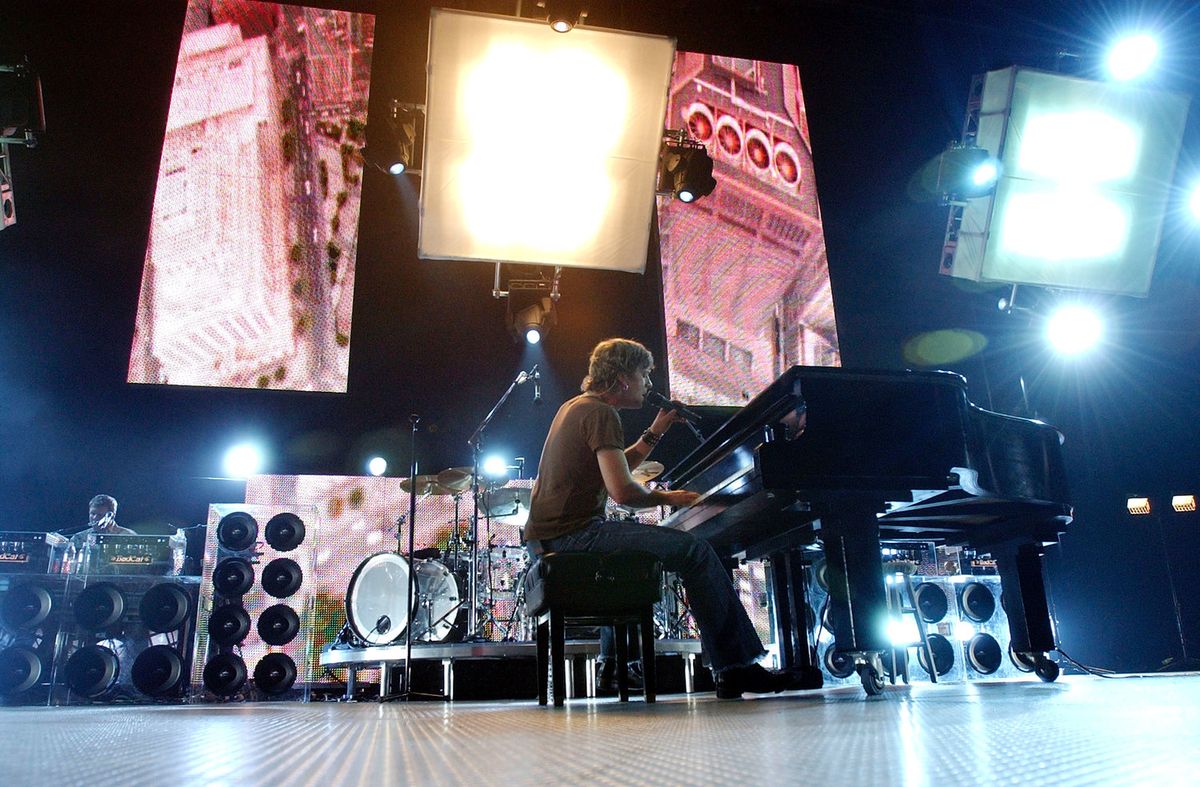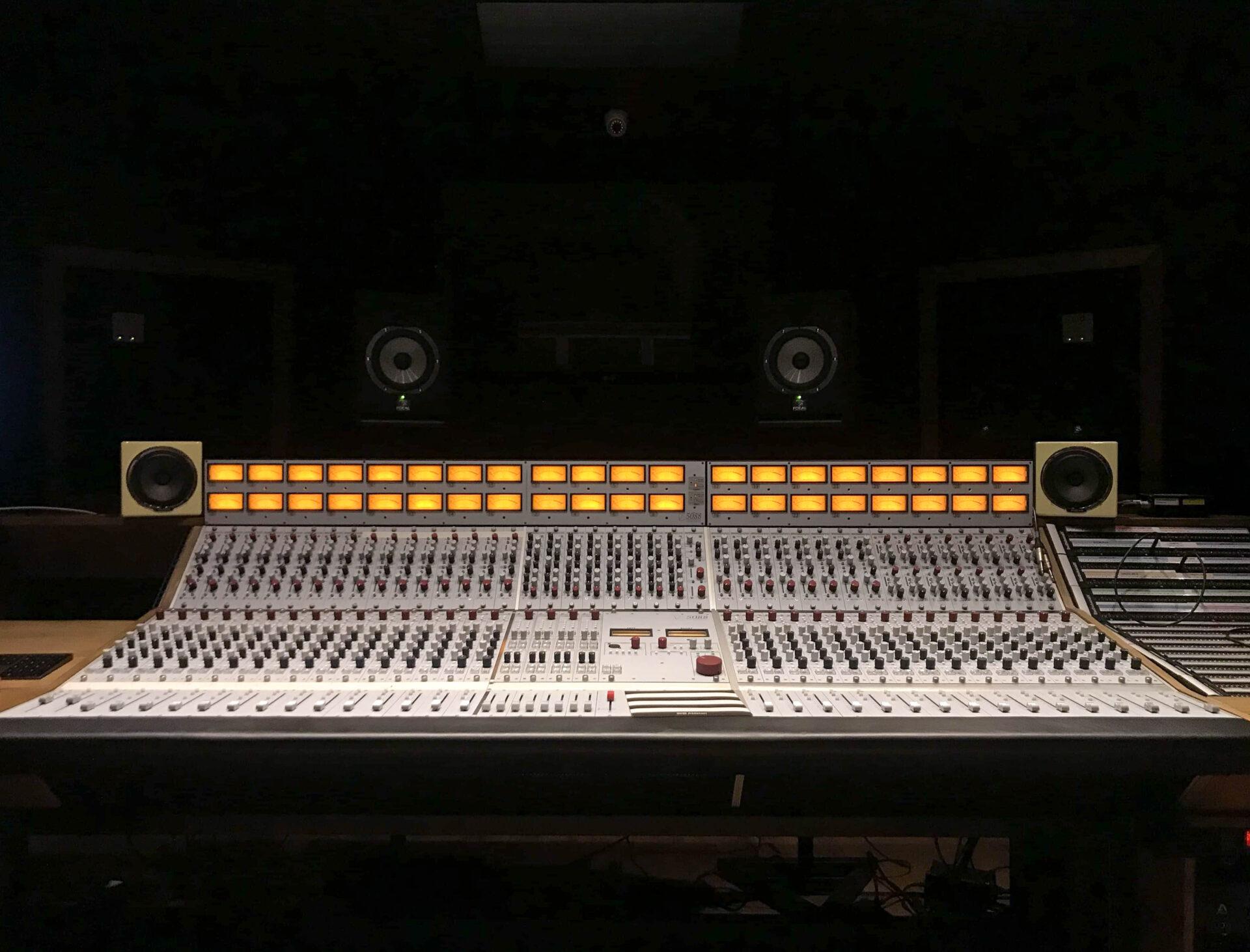

Rock
How Do Rock Bands Play Music Without Sheet
Modified: February 15, 2024
Discover how rock bands unleash their electrifying sound without the need for sheet music. Explore the intricate techniques and improvisation that bring rock music to life.
(Many of the links in this article redirect to a specific reviewed product. Your purchase of these products through affiliate links helps to generate commission for AudioLover.com, at no extra cost. Learn more)
Table of Contents
Introduction
When it comes to rock bands, one might automatically think of passionate musicians strumming guitars, pounding on drums, and belting out powerful vocals. But have you ever wondered how rock bands are able to perform their music flawlessly without relying on sheet music? In this article, we’ll explore the fascinating world of rock band performances and delve into the techniques they use to create incredible music without the need for traditional written music.
Unlike classical orchestras or jazz ensembles that heavily rely on sheet music to guide their performances, rock bands have developed a unique approach to playing music. Instead of meticulously reading sheet music note by note, rock bands embrace the improvisational nature of their genre, allowing them to create music on the spot and adapt to the energy of the live performance. This emphasis on spontaneity and musical freedom is what sets rock bands apart from other musical groups.
Rock bands utilize a combination of musical communication, memorization, rehearsals, and technology to ensure that their performances are tight and cohesive. Each band member has a deep understanding of their individual roles within the ensemble and relies on cues and signals to navigate through the music. By honing their musical intuition and relying on their ears, rock band members are able to synchronize their playing and create a powerful musical experience for their audience.
Technology also plays a crucial role in modern rock band performances. While traditional rock bands may not rely on sheet music, they do utilize technology such as in-ear monitors and metronomes to stay in sync with each other. These devices help the band members maintain a consistent tempo and ensure that the performance remains tight and cohesive.
Join us as we embark on a journey to uncover the secrets behind rock bands and their ability to play music without the need for sheet music. From passionate improvisation to meticulous rehearsals, we’ll explore the methods that allow rock bands to create unforgettable performances that captivate audiences around the world.
The Role of Sheet Music in Music Performance
Sheet music has long been a staple in the world of music. It provides a standardized form of notation that allows musicians to read, interpret, and perform a piece of music accurately. Sheet music contains notations for melody, harmony, rhythm, and other musical elements, guiding musicians through the composition.
In classical and orchestral settings, sheet music is invaluable. It ensures that all performers are on the same page, following the composer’s intended arrangement meticulously. Musicians in these contexts rely heavily on sheet music to execute complex compositions with precision and accuracy.
However, in the realm of rock music, the reliance on sheet music is minimal. Rock bands thrive on the energy and spontaneity of live performances, embracing a more improvisational approach to their music-making. This departure from the rigidity of sheet music allows rock musicians to express themselves freely and create unique renditions of their songs.
Unlike classical musicians, rock band members often write their own music. They develop a deep understanding of their compositions through the creation process, internalizing the melodies, chord progressions, and song structures. This familiarity enables them to perform the music without the need for sheet music as a visual guide.
Moreover, rock band members often rely on their instincts and musical intuition during live performances. They communicate with one another through musical cues and signals, making split-second decisions that keep the music flowing seamlessly. This level of musical telepathy is cultivated through countless hours of rehearsal and shared musical experiences.
While sheet music does not play a prominent role in rock band performances, it is worth noting that many rock musicians can read and understand sheet music. This knowledge often comes from their early musical training or exposure to other genres. While not necessary for their rock performances, this ability allows them to explore different musical styles and collaborate with musicians from diverse backgrounds.
Ultimately, the role of sheet music in rock band performances is limited. Instead, rock bands rely on their musical communication, memorization skills, intuition, and experience to create captivating performances. The absence of sheet music gives them the freedom to experiment and make each rendition of a song unique, ensuring that no two live performances are ever the same.
Rock Bands and Improvisation
One of the defining characteristics of rock bands is their ability to improvise. Improvisation is the art of creating music in the moment, without relying on pre-written compositions or sheet music. This improvisational spirit is deeply ingrained in the DNA of rock music and is a key element in the electrifying energy they bring to their performances.
Rock bands often use a basic framework for their songs, including chord progressions and song structures. Within this framework, they have the freedom to explore and create spontaneous musical moments. Each band member adds their unique touch, infusing the music with their own style and improvisational ideas. This collaborative process allows the band to create fresh and dynamic performances that keep the audience captivated.
Improvisation in rock bands is not limited to just the instrumentalists. Vocalists also have the opportunity to showcase their improvisational skills, adding melodic embellishments, ad-libs, and variations to their vocal performances. This improvisational element brings a sense of spontaneity and excitement to the music, making each live performance a unique experience.
Furthermore, improvisation is also a means for rock bands to connect with their audience on a deeper level. During live performances, bands can read the energy of the crowd and tailor their improvisations to match the mood or vibe of the audience. This interaction creates an intimate bond between the band and the audience, making the experience truly special and memorable.
While improvisation is an integral part of rock band performances, it is not a skill that is acquired overnight. It requires years of practice, a deep understanding of music theory, and a strong musical connection among band members. Through countless hours of jamming, rehearsing, and experimenting, rock bands develop a musical language that allows them to communicate seamlessly and create captivating improvisations.
It is important to note that although improvisation is inherent in rock band performances, it does not mean that every single part of a song is improvised. There is a delicate balance between structured composition and spontaneous improvisation. Rock bands often strike this balance by incorporating improvised sections within their songs, allowing them to showcase their individual skills while maintaining the overall structure of the music.
Ultimately, improvisation is the heartbeat of rock bands. It fuels their creativity, brings a sense of excitement and unpredictability to their performances, and allows them to connect with their audience on a profound level. With each note and every moment of spontaneous creation, rock bands showcase the raw power and magic of live music.
Musical Communication and Memorization
Rock bands have their own unique language of musical communication that allows them to seamlessly perform without relying on sheet music. Through a combination of non-verbal cues, signals, and a deep understanding of their compositions, band members are able to communicate and navigate through the music effortlessly.
One of the primary modes of communication in rock bands is through eye contact. Band members often exchange glances, indicating transitions, dynamics, and changes in the music. These subtle visual cues serve as a roadmap, allowing everyone to stay in sync and make instantaneous adjustments during live performances.
In addition to eye contact, rock bands use various hand signals to communicate specific musical elements. A simple hand gesture can indicate a change in tempo, a repeat of a section, or a cue for a solo. These signals are typically established during rehearsals and become second nature to the band members, enabling them to communicate smoothly without having to rely on verbal instructions.
Memorization also plays a crucial role in rock band performances. Instead of reading sheet music, band members rely on their ability to memorize the music they have composed or learned. This memorization process involves internalizing the melody, chord progressions, and song structure, allowing the musicians to perform without the need for visual aids.
Band members often spend hours rehearsing and playing their songs repeatedly to ingrain them into their memory. By doing so, they develop a deep connection with the music, enabling them to perform with confidence and spontaneity. This level of memorization also gives them the freedom to explore improvisation and make on-the-spot decisions during live performances.
It is important to note that while memorization is a key aspect of rock band performances, it does not mean that the musicians play the exact same notes and melodies every time. Embracing the spirit of improvisation, rock band members may introduce variations or add their own flair to the music, keeping each performance fresh and exciting.
Through a combination of non-verbal communication and extensive memorization, rock bands create a cohesive and tight performance. The ability to understand each other’s musical intentions and execute them flawlessly is a testament to the strong bond and chemistry that exists within the band.
By relying on this unique form of musical communication and memorization, rock bands are able to deliver electrifying performances that capture the essence of their music and engage their audience in a powerful and immersive musical experience.
The Importance of Rehearsals
Rehearsals are a fundamental aspect of any rock band’s journey to mastery and flawless live performances. These practice sessions play a vital role in refining the band’s sound, strengthening their musical cohesion, and ensuring that their performances are tight, impactful, and error-free.
During rehearsals, rock bands have the opportunity to fine-tune their music and polish their arrangements. They work together to perfect the transitions between sections, tighten up the rhythm, and iron out any rough edges in their performance. This meticulous attention to detail ultimately leads to a more coherent and seamless live show.
Rehearsals also allow band members to develop a unified sense of timing. Within a rock band, each instrument plays a crucial role in driving the music forward. By practicing together, bands can synchronize their playing, ensuring that the rhythm section (drums and bass) locks in seamlessly with the guitar and vocals. This tightness enhances the band’s overall sound and creates a powerful groove that captivates the audience.
Moreover, rehearsals provide an opportunity for band members to experiment and explore new ideas. They can collaborate on song arrangements, try out different musical approaches, and collectively contribute to the evolution of their music. This creative freedom allows for the development of unique interpretations and arrangements that make their performances stand out.
Rehearsals are also a time for rock band members to build trust and camaraderie. By spending countless hours together, they develop a deep understanding of one another’s musical sensibilities and strengths. This bond fosters seamless communication, allowing for intuitive musical interactions during performances. The more a band rehearses, the more they become attuned to each other’s playing and can anticipate musical changes and nuances.
Furthermore, rehearsals offer a platform for constructive criticism and feedback. Band members can provide input on each other’s performances, helping one another grow as musicians. This open and collaborative environment encourages continuous improvement and enables the band to reach new heights with each rehearsal.
While the process of rehearsing may be tedious at times, the results are well worth the effort. Consistent and rigorous rehearsals build the foundation for a rock band’s success by refining their sound, enhancing their musical communication, and ensuring a seamless and captivating live performance.
In essence, rehearsals are the backbone of a rock band’s journey towards excellence. They provide the opportunity for band members to refine their skills, strengthen their bond, and fine-tune their music. It is through this dedication and commitment to rehearsals that rock bands are able to deliver mesmerizing performances that leave a lasting impact on their audiences.
Musical Cues and Signals
One of the key elements in a rock band’s ability to perform without sheet music is their adept use of musical cues and signals. These cues serve as a form of non-verbal communication, allowing band members to navigate through the music, make seamless transitions, and stay synchronized during live performances.
Eye contact is a powerful tool in the realm of musical communication. Band members often lock eyes to signal important changes in the music, such as shifts in tempo, dynamics, or upcoming solos. A simple glance can serve as a cue for the band to transition to a different section or to build up to a climactic moment in the song. This visual communication helps keep everyone on the same page without the need for spoken instructions.
In addition to eye contact, hand signals play a significant role in rock band performances. A raised hand can indicate a change in tempo, while a downward motion may signify a decrescendo. A quick pointing gesture might direct a band member to take a solo, and a clenched fist could signal the end of a song. These signals are carefully coordinated and established during rehearsals, ensuring that the entire band understands their meaning and can respond accordingly.
Non-verbal cues also extend to more subtle body movements, such as a nod or a head tilt. These gestures can convey a variety of musical instructions, from emphasizing a particular beat to signaling a key change or modulation. Band members are attuned to each other’s body language and use these cues to adapt and respond to the ever-changing dynamics of a live performance.
Moreover, many rock bands utilize musical cues within the music itself. These cues can take the form of specific riffs, chord progressions, or rhythmic patterns that act as signals for the next section or change in the music. For example, a distinctive guitar riff might herald the start of a chorus, or a rhythmic breakdown could indicate a transition to a bridge. These musical cues serve as guideposts for the band members, allowing them to navigate through the song without the need for verbal communication.
The effective use of musical cues and signals requires a high level of synchronized communication among band members. It is a skill that is cultivated through countless hours of rehearsal and shared musical experiences. Through this musical telepathy, band members develop a deep understanding of each other’s playing styles, allowing them to anticipate and react to musical changes instinctively.
By harnessing the power of musical cues and signals, rock bands create cohesive and captivating performances. These non-verbal forms of communication enable them to navigate through the music seamlessly, making split-second decisions and adjustments that contribute to the overall energy and impact of their live shows.
Technology and Rock Band Performances
While rock bands are known for their raw and organic sound, technology has become an integral part of enhancing their live performances. From advanced sound systems to innovative stage setups, rock bands have embraced technology to elevate their music and deliver unforgettable experiences to their audiences.
One of the technologies commonly used by rock bands is in-ear monitoring systems. These systems allow each band member to have a personalized mix of the music they need to hear on stage. By eliminating the need for bulky stage monitors and relying on small, discreet earpieces, in-ear monitoring systems provide better clarity, control, and overall sound quality. This allows band members to hear themselves and the rest of the band more clearly, enabling tighter coordination and improved performances.
Metronomes, another technological tool, help rock bands maintain precise timing during live performances. While rock music is known for its dynamic and energetic nature, it is essential for the band members to stay in sync with each other. Metronomes provide a steady click or beat that helps keep everyone on the same tempo, ensuring that the performance remains tight and cohesive. This technology is particularly useful when playing complex rhythms, transitions, or time signature changes, helping the band members stay synchronized throughout the song.
Live sound mixing consoles play a crucial role in delivering a balanced and immersive sound experience to the audience. These consoles allow sound engineers to adjust and control the levels of each instrument and vocal in real-time. With the ability to finely tune the sound, sound engineers can ensure that the band’s performance is sonically compelling and well-adjusted to the venue’s acoustics. This technology helps create a professional and polished sound for the audience to enjoy.
Visual elements and stage effects are also commonly integrated into modern rock band performances. This includes lighting systems, video projection, and special effects such as pyrotechnics or smoke machines. These visual technologies add an extra layer of excitement and spectacle to the live show, enhancing the overall impact of the performance and immersing the audience in a multisensory experience.
Furthermore, advancements in recording technology have allowed rock bands to capture their live performances with greater precision and quality. High-definition multi-track recording equipment and software enable bands to document their shows for future reference or to release live albums or concert videos. This technology gives fans the opportunity to relive the energy and excitement of a live performance, even if they weren’t able to attend in person.
While technology has undoubtedly enhanced rock band performances, it is essential for bands to strike a balance between technological innovation and maintaining the raw essence of their music. Rock bands continue to embrace technology as a tool to enhance their live shows while preserving the passion, energy, and authenticity that define their genre.
Overall, technology has become an indispensable component of modern rock band performances. It enables bands to deliver high-quality sound, synchronized performances, and visually stunning shows, providing audiences with unforgettable experiences that push the boundaries of live music.
Conclusion
Rock bands have a distinct ability to create powerful, mesmerizing music without the reliance on sheet music. Through improvisation, musical communication, and extensive rehearsals, rock bands develop a deep connection that allows them to perform flawlessly and captivate audiences. Their music is a testament to the power of human creativity and collaboration.
While sheet music plays a vital role in other musical genres, rock bands thrive on the freedom to improvise and create music on the spot. This artistic spontaneity allows them to showcase their individuality and connect with audiences on a profound level. By relying on musical cues, signals, and a deep understanding of their compositions, rock bands navigate through the music seamlessly, creating a cohesive and electrifying performance.
Rehearsals play a crucial role in the success of rock band performances. These practice sessions allow band members to refine their sound, synchronize their playing, and experiment with new ideas. The hours spent rehearsing build a strong bond and musical telepathy among band members, facilitating intuitive communication on stage.
Technology has also made its way into rock band performances, offering tools such as in-ear monitoring systems and metronomes to enhance timing and sound quality. Visual technologies, such as lighting and special effects, add a visually stunning element to live shows, enhancing the overall experience for both the band and the audience.
In conclusion, the ability of rock bands to perform without sheet music is a testament to their artistry, dedication, and connection as musicians. Through improvisation, musical communication, and rigorous rehearsals, these bands create awe-inspiring music experiences that leave a lasting impact. Rock bands continue to push the boundaries of musical expression, capturing the essence of the genre’s rebellious and passionate spirit.
So, the next time you see a rock band take the stage, marvel at their ability to perform without sheet music and appreciate the seamless musical communication that happens among them. It is a testament to their talent, dedication, and the power of human expression through music.











